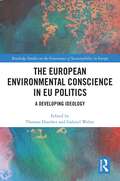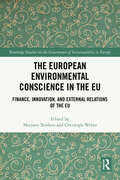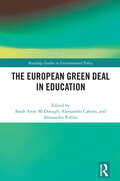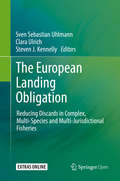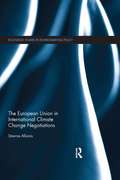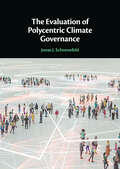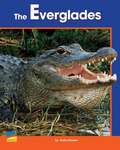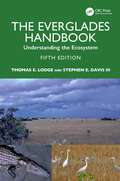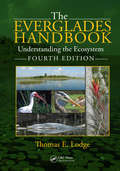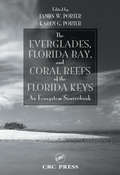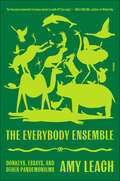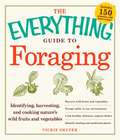- Table View
- List View
The European Dimension of Germany’s Energy Transition: Opportunities and Conflicts
by Alexandra Purkus Erik Gawel Sebastian Strunz Paul LehmannThis book addresses the interactions between Germany’s energy transition and the EU’s energy policy framework. It seeks to analyze the manifold connections between the prospects of the proclaimed “Energy Union” and the future of Germany’s energy transition, and identifies relevant lessons for the transformation at the EU level that can be learned from the case of Germany, as a first-mover of transforming energy systems towards renewables. The various repercussions (political, economic and systemic) from the national transition are explored within the EU context as it responds to the German transition, taking into account both existing frictions and potential synergies between predominantly national sustainability policies and the EU’s push towards harmonized policies within a common market. The book’s overall aim is to identify the most critical issues, in order to avoid pitfalls and capitalize on opportunities.
The European Environmental Conscience in EU Politics: A Developing Ideology (Routledge Studies on the Governance of Sustainability in Europe)
by Thomas HoerberBased on empirical studies of European energy and environmental policies, this book suggests that, in combination, these two policy fields form a consensus in the EU which might also become the basis for a new European ideology, namely European ‘sustainabilism’. It asks why an environmental conscience has grown since the late 1960s in the industrialised world and shows that whilst there is undeniable environmental degradation during this time, and that a European environmental conscience has mainly developed through successive steps of European integration in energy policy. In this connection between energy and the environmental we find one driver for European integration and indeed European identity. If sustainabilism should become a European ideology, it will substantially influence the way future Europeans will live. This book will be of key interest to scholars and students of European Studies, International Relations, Political Science, History, Economics, Sustainability Studies, Environmental and Energy Policies in Europe.
The European Environmental Conscience in the EU: Finance, Innovation, and External Relations of the EU (Routledge Studies on the Governance of Sustainability in Europe)
by Christoph Weber Marjorie TenderoThis book analyses how sustainability affects internal decision-making within the European Union and its external relations in working towards achieving its long-term goal of a climate-neutral Europe by 2050.Applying the term "European environmental conscience" as the perception of environmental degradation leading to a growing public awareness of the issues, a notion of common responsibility, and European institutions dealing with these growing concerns, the book investigates its emergence as a lever for deeper European integration and in fostering a genuine European identity. Examining policy areas such as green finance, innovation policies, and foreign policy, it reveals the impact these concerns have for other policy fields.This book is of key interest to scholars and students of environmental economics and politics, sustainability governance, green finance, climate policy, energy policy, and more broadly, to European studies and international relations.
The European Green Deal in Education (Routledge Studies in Environmental Policy)
by Alessandro Caforio Alessandro Pollini Sarah Anne McDonaghThis book shares real-life case studies taken from GreenSCENT, a three-year EU-funded project that promotes sustainability through the development of digital platforms and tools, green education programme, and climate and environmental literacy certification.To date there has been little work published on the application of the European Green Deal in educational programmes and, while environmental education is very dynamic at present, this area has received scant attention. Seeking to remedy this critical omission, this book represents the first application of the Green Deal topics in the classroom. It examines environmental education from an academic perspective, looking specifically at the development of digital tools used to promote sustainability and provides recommendations for their practical application. The authors also discuss ways to engage larger and more diverse audiences (children, young people, and adults across socio-economic, cultural, and ethnic backgrounds) on the topic of sustainability through activities such as air quality monitoring, Climathons, and Youth Assemblies.As the highlighting factors are inclusivity, accessible design, and responsible research and innovation, this volume will be of great interest to students and scholars of European environmental policy and environmental education.
The European Landing Obligation: Reducing Discards In Complex, Multi-species And Multi-jurisdictional Fisheries
by Sven Sebastian Uhlmann Clara Ulrich Steven J. KennellyThis open access book provides a comprehensive examination of the European Landing Obligation policy from many relevant perspectives. It includes evaluations of its impacts at economical, socio-cultural, ecological and institutional levels. It also discusses the feasibility and benefits of several potential mitigation strategies. The book was timely published, exactly at the time where the Landing Obligation was planned to be fully implemented. This book is of significant interest to all stakeholders involved, but also to the general public of Europe and to other jurisdictions throughout the world that are also searching for ways to deal with by-catch and discard issues.
The European Landing Obligation: Reducing Discards in Complex, Multi-Species and Multi-Jurisdictional Fisheries
by Sven Sebastian Uhlmann Clara Ulrich Steven J. KennellyThis open access book provides a comprehensive examination of the European Landing Obligation policy from many relevant perspectives. It includes evaluations of its impacts at economical, socio-cultural, ecological and institutional levels. It also discusses the feasibility and benefits of several potential mitigation strategies. The book was timely published, exactly at the time where the Landing Obligation was planned to be fully implemented. This book is of significant interest to all stakeholders involved, but also to the general public of Europe and to other jurisdictions throughout the world that are also searching for ways to deal with by-catch and discard issues.
The European Landscape Convention
by Michael Jones Marie StensekeThis important and insightful book provides, for the first time, a broad presentation of ongoing research into public participation in landscape conservation, management and planning, following the 2000 European Landscape Convention which came into force in 2004. The book examines both the theory of participation and what lessons can be learnt from specific European examples. It explores in what manner and to what extent the provisions for participation in the European Landscape Convention have been followed up and implemented. It also presents and compares different experiences of participation in selected countries from northern, southern, eastern and western Europe, and provides a critical examination of public participation in practice. However, while the book's focus is necessarily on Europe, many of the conclusions drawn are of global relevance. The book provides a valuable reference for researchers and advanced students in landscape policies and management, as well as for professionals and others interested in land-use planning and environmental management.
The European Union and Global Environmental Protection: Transforming Influence into Action (Routledge Studies in Environmental Policy)
by Mar Campins EritjaThis book examines how the EU can be a more proactive actor in the promotion of the principles of sustainability and fairness from a legal environmental perspective. The book is one of the results of the research activity of the Jean Monnet Chair in EU Environmental Law (2017-2020) funded by the European Commission under the Erasmus+ programme. The European Union and Global Environmental Protection: Transforming Influence into Action begins with an introduction of the key EU competences, instruments and mechanisms, as well as the current international challenges at the EU level. It then explores case study examples from four regulated fields: climate change, biodiversity, multilateral trade, unregulated fishing, and access to justice; and four unregulated areas: mainstreaming of the Sustainable Development Goals in EU policies, and environmental justice, highlighting the extent to which the EU might align with international environmental regimes or extend its normative power. This volume will be of great relevance to students, scholars, and EU policy makers with an interest in international environmental law and policy.
The European Union and Multilateral Governance
by Jan Wouters Hans Bruyninckx Sudeshna Basu Simon SchunzAn interdisciplinary approach to the study of the EU in UN human rights and environmental governance which addresses the legal and political science dimensions. With contributions from academics and policy-makers, this volume is a comprehensive analysis of how the challenges it faces impact on the EU's position in UN fora.
The European Union in International Climate Change Negotiations (Routledge Studies in Environmental Policy)
by Stavros AfionisThe EU has been portrayed as a leader in international climate change negotiations. Its role in the development of the climate change regime, as well as the adoption of novel policy instruments such as the EU Emissions Trading Scheme in 2005, are frequently put forward as indicative of a determination to push the international climate agenda forward. However, there are numerous instances where the EU has failed to achieve its climate change objectives (e.g. the 2009 Copenhagen Conference of the Parties). It is therefore important to examine the reasons behind these failures. This book explores in detail the involvement of the EU in international climate talks from the late 1980s to the present, focusing in particular on the negotiations leading up to Copenhagen. This conference witnessed the demise of the top-down approach in climate change policy and dealt a serious blow to the EU’s leadership ambitions. This book explores the extent to which negotiation theory could help with better comprehending the obstacles that prevented the EU from getting more out of the climate negotiation process. It is argued that looking at the role played by problematic strategic planning could prove highly instructive in light of the Paris Agreement. This broad historical perspective of the EU’s negotiations in international climate policy is an important resource to scholars of environmental and European politics, policy, law and governance.
The Evaluation of Polycentric Climate Governance
by Jonas J. SchoenefeldPolycentric climate governance holds enormous promise, but to unleash its full force, policy evaluation needs a stronger role in it. This book develops Nobel Laureate Elinor Ostrom's important work by offering fresh perspectives from cutting-edge thinking on climate governance and policy evaluation. Driven by theoretical innovation and empirical exploration, this book not only argues for a stronger connection between polycentric climate governance and practices of evaluation, but also demonstrates the key value of doing so with a real-world, empirical test in the polycentric setting of the European Union. This book offers a crucial step to take climate governance to the next level. It will be of interest to advanced students and researchers in climate governance, as well as practitioners who seek to enhance climate action, which is needed to avoid a climate catastrophe and to identify a pathway towards the 1.5° Celsius target in the Paris Agreement.
The Everglades
by Kathy KinsnerThis book is about the history of the Everglades, the geographical conditions responsible of its unique wetlands, and the plants and animals that live there.
The Everglades Handbook: Understanding the Ecosystem
by Thomas E. Lodge Stephen E. Davis IIIThe Everglades Handbook: Understanding the Ecosystem, Fifth Edition is packed with scientific information about the greater Everglades ecosystem, taking into account how drastically the Everglades has changed. The book covers disciplines ranging from ecology, geology, climatology, hydrology, simplified biogeochemistry, and anthropology to conservation biology. The fifth edition of this bestselling guide presents expanded treatment of subjects where our knowledge of the Everglades and its restoration has greatly improved as well as updates throughout. This more detailed coverage includes a new chapter ‘Everglades Chemistry – A Primer’ and an expanded section on the role of human intervention in Everglades restoration, as well as numerous new graphics that bring the science to life. Written in Tom Lodge’s trademark accessible style combined with the expertise of new coauthor Stephen E. Davis III, Chief Science Officer with the Everglades Foundation, this extensively researched text is essential reading for anybody trying to understand the challenges we face in restoring this unique ecosystem.
The Everglades Handbook: Understanding the Ecosystem, Fourth Edition
by Thomas E. Lodge"This fourth edition covers the key subjects of previous editions with major updates of the new science and understanding. If there ever was a necessary book for Everglades advocates, students, authors, members of government and their agencies, The Everglades Handbook: Understanding the Ecosystem is an absolute must!" —Nathaniel P. Reed, from the Foreword “This book is far and away the best guide now in print to Everglades issues -- authoritative, well-illustrated, well-indexed, and readable." — Martha Musgrove, retired Miami Herald journalist, founding President of the Decision Makers Forum, and Southeast Regional Director of the Florida Wildlife Federation "Given the astonishing breadth and depth of scientific activities in the Everglades, Tom Lodge once again illustrates his savvy as an articulate science writer in condensing the complex dynamics of this remarkable ecosystem. …In summary, the Handbook reviews a vast literature into a compelling read about the natural treasures of the Everglades."—Evelyn E. Gaiser, Executive Director, School of Environment, Arts and Society, and Associate Dean, College of Arts & Sciences, Florida International University, modified from Wetlands (2011) 31 _____________________________________________________________________________________ The fourth edition presents expanded treatment of subjects where our knowledge of the Everglades and its restoration has greatly improved. This more detailed coverage includes: Computer modeling and its applications to the Everglades environment Quantified role of water flow in shaping the Everglades landscape The origin and evolution of fixed tree islands Sulfur and related mercury as wetland pollutants Up-to-date summary of the now quantified economic benefits of restoration, shown to be far in excess of the cost The Everglades Handbook: Understanding the Ecosystem, Fourth Edition is a scholarly reference packed cover to cover with scientific information about the ecosystem of the Everglades - taking into account how drastically the Everglades has changed. Topically, the book covers disciplines ranging from ecology, geology, climatology, hydrology, anthropology to conservation biology. Written in Tom Lodge’s trademark accessible style, this extensively researched text is essential reading for anybody trying to understand the challenges we face in restoring this unique ecosystem.
The Everglades, Florida Bay, and Coral Reefs of the Florida Keys: An Ecosystem Sourcebook
by James W. Porter Karen G. PorterProviding a synthesis of basic and applied research, The Everglades, Florida Bay, and Coral Reefs of the Florida Keys: An Ecosystem Sourcebook takes an encyclopedic look at how to study and manage ecosystems connected by surface and subsurface water movements. The book examines the South Florida hydroscape, a series of ecosystems linked by hydrolog
The Everglades: Stories of Grit and Spirit from the Mangrove Wilderness
by Holly Genzen Anne McCrary SullivanEverglades National Park&’s mangrove ecosystem, extending over 230,000 acres of south Florida, is the most expansive in the western hemisphere and the largest continuous system of mangroves in the world. Most of this mangrove area is remote, accessible only by boat, complex and difficult to navigate. In The Everglades: Stories of Grit and Spirit from the Mangrove Wilderness we hear 21 stories from people who have ventured into this wilderness—for scientific work, artistic work, search-and-rescue missions, for personal renewal, or for the pure adventure of it. They tell stories of manatee rescue, shark encounters, storms and strandings, stories of environmental value and threat, wild beauty, personal enchantment and spirit. Together these stories reveal a world beyond the reach of most travelers. They also offer support and offer enticement to the intrepid few who may venture &“out there&” and return with stories of their own.
The Everybody Ensemble: Donkeys, Essays, and Other Pandemoniums
by Amy LeachIn short, gloriously inventive essays, Whiting Award-winning author Amy Leach's The Everybody Ensemble invites us to see and celebrate our oddball, interconnected worldHumans, please turn your guns into kazoos.Are you feeling dismay, despair, disillusion? Need a break from the ho-hum, the hopeless, and the hurtful? Feel certain that there’s a version of our world that doesn’t break down into tiny categories of alliance but brings everybody together into one clattering, sometimes discordant but always welcoming chorus of glorious pandemonium?Amy Leach, the celebrated author of the transcendent Things That Are, invites you into The Everybody Ensemble, an effervescent tonic of a book. These short, wildly inventive essays are filled with praise songs, poetry, ingenious critique, soul-lifting philosophy, music theory, and whimsical but scientific trips into nature. Here, you will meet platypuses, Tycho Brahe and his moose, barnacle goslings, medieval mystics, photosynthetic bacteria, and a wholly fresh representation of the biblical Job.Equal parts call to reason and to joy, this book is an irrepressible celebration of our oddball, interconnected world. The Everybody Ensemble delivers unexpected wisdom and a wake-up call that sounds from within. For readers of Ross Gay, Eula Biss, Anne Lamott, Annie Dillard, Ralph Waldo Emerson, and even Lewis Carroll, these twenty-four essays will be a perfect match.
The Everyday Naturalist: How to Identify Animals, Plants, and Fungi Wherever You Go
by Rebecca LexaLearn to identify animals, plants, and fungi wherever you go with this step-by-step guide for spotting and recording key traits and characteristics.If you've ever consulted a field guide to identify a new bird at your feeder, you know the process isn't as easy as it sounds. In fact, it seems like you have to know a lot about that mystery bird to even figure out where to start.The Everyday Naturalist fills in the gaps by explaining what traits to pay attention to when encountering a new species; how and when to use field guides, apps, and other resources; what to do if you get stuck; and more. Rather than focusing on one region or continent, these skills and tools are designed to help you classify nature anywhere you are—whether on familiar territory, traveling, or in a new home.In chapters about animals, plants, fungi, and organisms like lichens and slime molds, naturalist and guide Rebecca Lexa goes into detail about what sets each of these kingdoms apart from each other—from color, shape, and texture to reproductive characteristics, behavior, and habitat—and includes more than forty full-color photos and drawings to illustrate key points. She also provides detailed case studies to demonstrate how to use all of these traits to identify specimens across multiple kingdoms.This easy-to-follow guide empowers you to learn more about the species around you, then use what you know to preserve the world you love. And at a time when biodiversity is imperiled worldwide, nature needs more advocates than ever.
The Everything Family Guide To RV Travel And Campgrounds
by Marian EureTraveling in an RV offers the excitement of a road trip without the cost and worry of food and shelter. It's perfect for adventurous families who want take in all of nature's beauty without losing the comfortable amenities of home. With The Everything Family Guide to RV Travel and Campgrounds at your side, you'll tour America in style - or simply unwind at your local campground.From choosing the right vacation spot to packing and planning, this all-in-one road includes:Tips for buying the perfect RVRecommended food preparation for your tripGuidance for traveling with petsAn extensive campground directoryGreat on-the-road activities for kidsAdvice for traveling on a budget . . . or on a spreeand moreThe Everything Family Guide to RV Travel and Campgrounds is all you need to plan your most exciting family vacation yet!
The Everything Family Guide to RV Travel and Campgrounds
by Marian EureTraveling in an RV offers the excitement of a road trip without the cost and worry of food and shelter. It's perfect for adventurous families who want take in all of nature's beauty without losing the comfortable amenities of home. With The Everything Family Guide to RV Travel and Campgrounds at your side, you'll tour America in style - or simply unwind at your local campground.From choosing the right vacation spot to packing and planning, this all-in-one road includes: Tips for buying the perfect RV, Recommended food preparation for your trip, Guidance for traveling with pets, An extensive campground directory, Great on-the-road activities for kids, Advice for traveling on a budget . . . or on a spree and more. The Everything Family Guide to RV Travel and Campgrounds is all you need to plan your most exciting family vacation yet!
The Everything Guide to Foraging
by Vickie ShuferFrom the field to your table-- how to find and prepare wild foods. This is your one-stop reference for identifying and harvesting the wild fruits and vegetables that grow in fields, forests, and even on your own lawn.
The Everything Guide to Foraging
by Vickie ShuferIf you're searching for the freshest fruits and vegetables to add to your diet, you don't have to look any further than your own backyard! With dozens of detailed illustrations, color photos, and more than 150 tasty recipes, this guide is your ultimate one-stop reference for identifying and harvesting the wild fruits and vegetables that grow in fields, forests, and even on your own lawn. Inside you'll find: In-depth descriptions of edible plants, including their likely locationsEasy and delicious recipes for your wild harvestA primer on careful foraging techniques and conservation ethicsEssential information on poisonous look-alikesFrom clover and cattails to milkweed and mustard, this book will teach you how to collect and prepare some of the most common--and delicious--feral plants in America. And, more than just a way to a fantastic meal, this book will guide you to both a newfound confidence in your own abilities, as well as a greater appreciation of the natural world.

